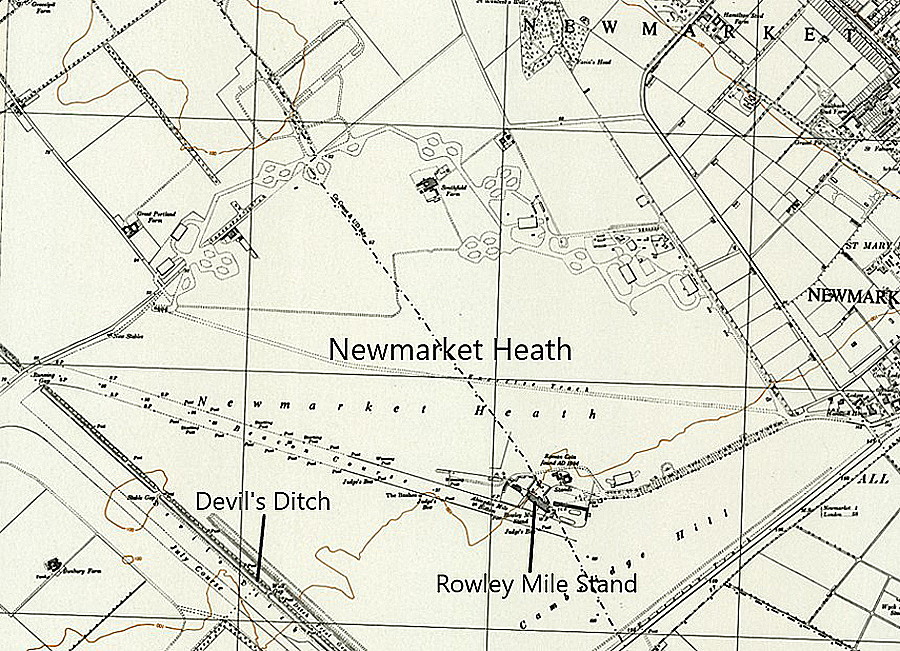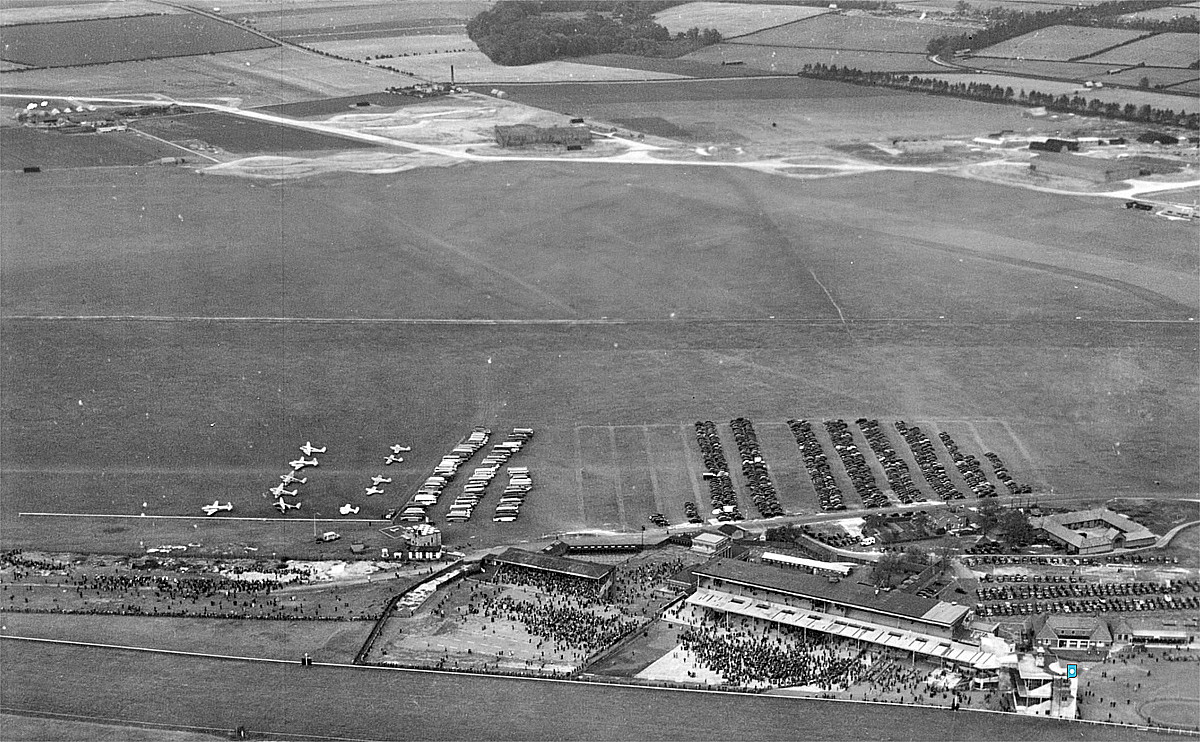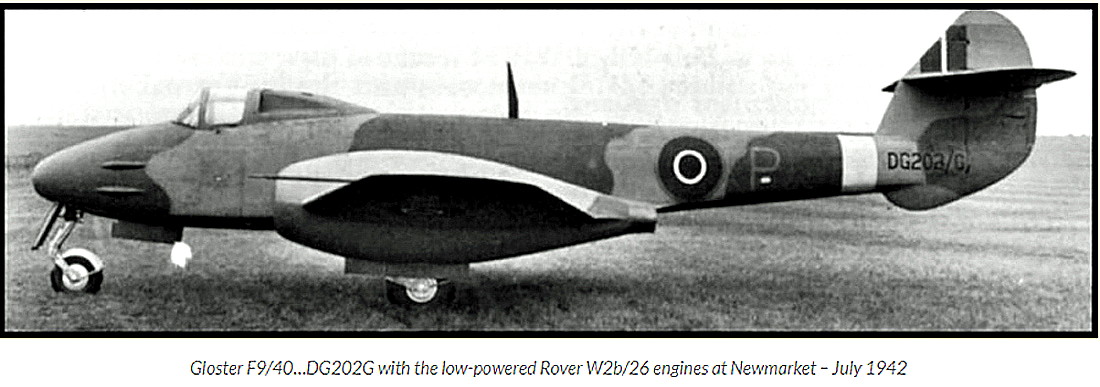Newmarket military
THE MAIN NEWMARKET FLYING SITES
It is important to first point out that the main flying sites, both military and civil, since WW1 to today, are all in pretty much the same area. Namely on Newmarket Heath. The reason for this 'Guide' having three seperate listings for NEWMARKET, is mainly because it serves to illustrate the quite seperate purposes aviation activities have served. And yes, I am now quite happy to admit that when starting this project over twenty five years ago, I made the serious mistake of thinking that the pieces of information I was discovering, over such a long period of time historically, must surely relate to quite seperate locations geographically.
A MICHAEL T HOLDER GALLERY
We have Mike Holder, a great friend of this 'Guide', to thank for doing the research which ties in, so neatly, the history and geography.
Excerpt One is from Aviation Landmarks - Norfolk and Suffolk, by Peter B Gunn.
Excerpt Two and Three are both from the Cambridge Aviation Chronicle by Mike Petty. Photo One, of the Dragon Rapide is from Action Stations - see below.
ACTION STATIONS
The Action Stations series of books are quite rightly regarded as being amongst the best sources of knowledge and information available regarding the history of WW2 aerodromes. These items, in six parts, are from the book written by Michael J F Bowyer.
Excerpt Four is also from Cambridge Aviation Chronicle by Mike Petty. Photo Three shows one of the two Bellman hangars built during WW2 on the north side of Newmarket Heath.
Photo Four is an aerial shot taken in 1948. Note five DH89A Dragon Rapides, and, in front, a DH104 Dove. A design intended to replace the Dragon Rapide which made its first flight in September 1945.
Photo Five was obtained from the Newmarket Local History Society. Photo Six is another view of the ROWLEY MILE, 29th September 1948.
The area view is from my Google Earth © derived database.
NEWMARKET: Military aerodrome WW1
Military users: RFC/RAF Home Defence Night & Landing Ground
51 & 75 Sqdns 1916 to 1919
Night Training Squadron Station
190 Sqdn (Airco DH.6s & Avro 504Ks) 1917 to 1919
192 Sqdn (Royal Aircraft Factory FE.2bs & FE.2ds)
Location: Pretty much the same site/area as listed as NEWMARKET HEATH in WW2.
Period of operation: 1916 to 1919
Site area: 125 acres 914 x 549
NOTES: Seeing a very rare photograph of RFC Avro 504J B8593 attributed to being taken at Newmarket in about 1917 was my first clue about it’s existence. Firmer details were provided by Mick Davis of Cross & Cockade.
NEWMARKET: Military aerodrome (also known as NEWMARKET HEATH)
Military users: WW2: RAF Bomber Command 3 Group
2 Sqdn (North American P-51 Mustangs)
75 Sqdn (Short Stirlings)
99 Sqdn (Vickers Wellingtons)
107 Sqdn (Bristol Blenheims)
138 Sqdn (Westland Lysanders & Armstrong Whitworth Whitleys)
161 [SD] Sqdn (Lysanders, Lockheed Hudsons and Whitleys)
453 Sqdn (Vickers-Supermarine Spitfires - staying one week only)
1688 (B) Defence Training Flt (Spitfires & Hawker Hurricanes)
Bomber Development Unit (Avro Manchesters (?), Handley Page Halifaxs, Avro Lancasters & DH Mosquitos)
Location: 1nm W of Newmarket – in WW2 pretty much on the combined racecourse grounds which exist today.
Period of operation:
WW2: 1939 to 1945? Actual operations seemed to cease in late 1944?
Runways: E/W 2286 grass SE/NW 1646 grass
NE/SW 1463 grass
NOTES: I just love history and it’s ramifications and echoes. When the Wellington bomber R1333 took off to raid Ludwigshafen at 21.28hrs on the 18th December 1940, it hit the 20ft high Devil’s Ditch, (it had only flown for just forty-two days), killing four and seriously injuring two of the six crew on board. Constructed in the 5th century it was still posing problems in the 20th!
I also mention this particular aircraft because of the combined 'Sods Law' and ‘jinx’ principle. R1333 was the ‘Broughton Wellington’ brought on subscription by the BROUGHTON, (FLINTSHIRE), factory workforce to the tune of £15,000. Initially it was badly damaged in the one and only air raid to RAF HAWARDEN on the 14th November 1940. A replacement Wellington, R1516 operated by 311 (Czech) squadron and given the same name, operating out of EAST WRETHAM in NORFOLK was shot down by a British night-fighter over WILTSHIRE.
As said elsewhere I’m sometimes amazed the RAF thought they needed an enemy in WW2, they were seemingly more than capable of destroying themselves given a bit more time! Especially during the early stages of WW2. The British Army and Royal Navy were very happy to assist the enterprise too, trying very hard to shoot down our own aircraft at the first opportunity. During the D-Day invasion American land forces did all they could too to shoot down aircraft fighting on their side aided to a large extent with the Royal Navy.
And, it should be borne in mind, the German Navy and the Luftwaffe had virtually no effective role to play in the D-Day landings! Plus, to try prevent this happening, all Allied Forces aircraft had distinctive black and white stripes painted across their wings and fuselages. It appears that few anti-aircraft gunners in the Navy and Army took any notice - they appear to have taken their anti-aircraft role literally.
In addition, it was often reported, (an interesting aspect of aerial warfare), was that having survived a mission against the enemy, quite often aircrews had to endure attack from their own naval and ground forces trying to get back to base!
AN INTERESTING ASPECT
Probably not much remembered today is that in May 1941 No.1419 Flight moved to NEWMARKET. They were engaged on highly secret missions, delivering agents, VIPs and supplies to and from resistence movements - mostly in France - and mostly by parachute drops. On the 25th August 1941, 1419 Flight became 138 Squadron. The Squadron then had seven Armstrong-Whitworth Whitleys, two long range Westland Lysanders and a Martin 167 Maryland - an American twin-engine bomber. Quite what use this latter aircraft was needed for, is not explained.
Later the Squadron moved to TEMPSFORD (BEDFORDSHIRE) along with 161 Squadron, where they stayed until the end of the war. This said, most of the actual operational sorties, were carried out from RAF TANGMERE in SUSSEX.
In February 1942, No.161 Squadron started to form at NEWMARKET. Its establishment was seven Westland Lysanders, five Armstrong-Whitworth Whitley V, two Vickers Wellingtons and one Lockheed Hudson from the King's Flight. Two pilots from 138 Squadron were transferred too, Flight Lieutenant A.M. Murphy (DFC) and Pilot Officer Guy Lockhart.
On the 1st March 1942, the Squadron was then moved to GRAVELEY. Clearly, those in charge, in the upper echelons of the RAF, were determined to upset the effectiveness of these 'Special Operations' and afford the Nazi regime every advantage they could. An aspect of the war in the air during WW2 which is now becoming increasingly obvious. And, this is not just my opinion. Indeed evidence is now emerging that this 'cloak and dagger' background spread far and wide, in Bomber Command at least. Incredibly deliberately planning the 'Dam Busters' raid to have the least effective consequences!
We'd love to hear from you, so please scroll down to leave a comment!
Leave a comment ...
Copyright (c) UK Airfield Guide




































